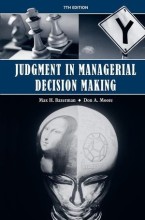Overconfidence & Optimism
17 important questions on Overconfidence & Optimism
What are some examples of biases in beliefs?
- Ignoring base rates (base rate neglect).
- Disregarding the importance of sample size (sample size neglect).
- Misconstruing random events as cyclical patterns (gambler’s fallacy).
- Erroneous belief in a winning streak (hot hand fallacy).
- Favoring information that confirms preexisting beliefs (confirmation bias).
- Overreliance on the first piece of information encountered (anchoring bias).
- Prioritizing information that is readily available (availability bias).
- Limitation in recognizing or processing information (bounded awareness).
- Judging based on stereotypes or similar past situations (representativeness biases).
What cognitive biases can affect accurate probability assessments for decision making purposes?
- Desire to feel sure of ourselves
- Desire to make others feel sure about us
- Confirmation bias
- Representativeness biases
- Anchoring
What is overconfidence and how does it relate to subjective confidence versus objective accuracy?
- Individuals often overestimate their knowledge and underestimate their limitations.
- Consequences include being frequently surprised due to inaccurate self-assessment.
- Higher grades + faster learning
- Never study anything twice
- 100% sure, 100% understanding
Why were weather forecasters nearly perfectly calibrated before computer algorithms?
- They were held accountable for their forecasts, providing an incentive to improve accuracy.
How does optimism bias affect the perceived likelihood of outcomes?
- People with this bias expect actions to have more favorable results than they might realistically achieve.
- As a result, optimists can often face disappointment when outcomes don't align with their expectations.
What did Weinstein (1980) find regarding people's optimism about the future?
- They perceived themselves 15% more likely for good things and 20% less likely for bad things
How are the concepts of overconfidence and optimism visually represented in the provided graphs?
- The overconfidence graph displays a narrow peak, indicating a small range where subjective confidence is high, often beyond actual accuracy.
- These visual representations symbolize the skew in judgment associated with each bias.
How did people in Weinstein's study seem to perceive their chances of experiencing events?
- They compared themselves to someone who doesn't improve their chances
What are the three groups of overconfidence as classified by Bazerman & Moore?
- Overestimation: Assessing one's actual performance higher than it truly is.
- Overplacement: Rating oneself as superior in performance compared to others.
What is the concept of the illusion of control?
- Occurs with an intended outcome + connection
- Examples include investing, slot machines, lottery numbers
What are the characteristics of the inside view when making predictions or judgments?
- Based on plans and personal impressions
- Tends to be more natural and optimistic
How does the outside view differ from the inside view in terms of approach and accuracy?
- Uses baseline statistics as the starting point for judgment
- Generally provides a more accurate perspective
Why do people often rely on the inside view rather than the outside view, and what is the result?
- This leads to overly optimistic outcomes
- The ideal approach combines both inside and outside views
What is the effect of asking individuals to consider past experiences on their predictions?
- Forces acknowledgment of past failures
- Influences the current prediction's relevance
What does the chart indicate about people's predictions regarding their own business success compared to similar businesses?
- The likelihood for any business like theirs succeeding is much lower at 39%
- Demonstrates optimism bias in personal prediction
What are the possible explanations for the planning fallacy?
- Neglect of past experiences due to the forward nature of prediction.
- Find it hard to define similar experiences.
- Subjects explain relevance of past with self-serving bias.
What are some exceptions to optimism discussed by Buehler, Griffin & Ross (1994)?
- Defensive pessimism: strategically lower expectations to cope with potential negative outcomes.
- Underplacement: often think tasks are easier for oneself than others.
The question on the page originate from the summary of the following study material:
- A unique study and practice tool
- Never study anything twice again
- Get the grades you hope for
- 100% sure, 100% understanding































